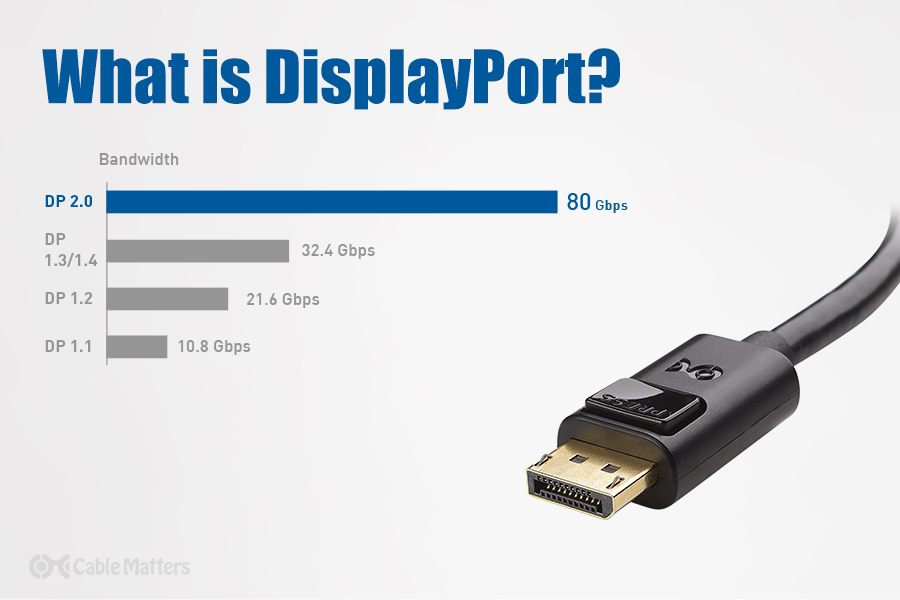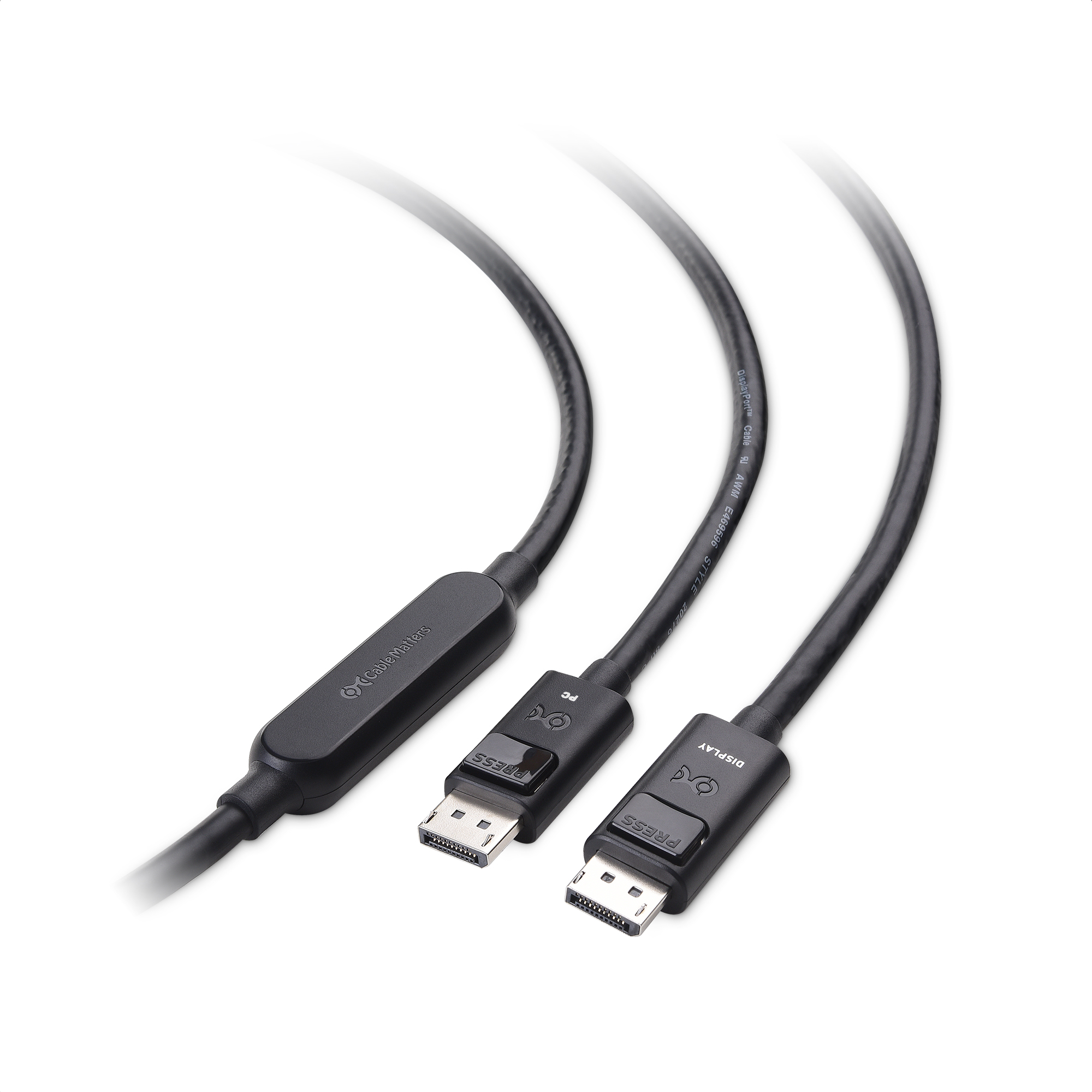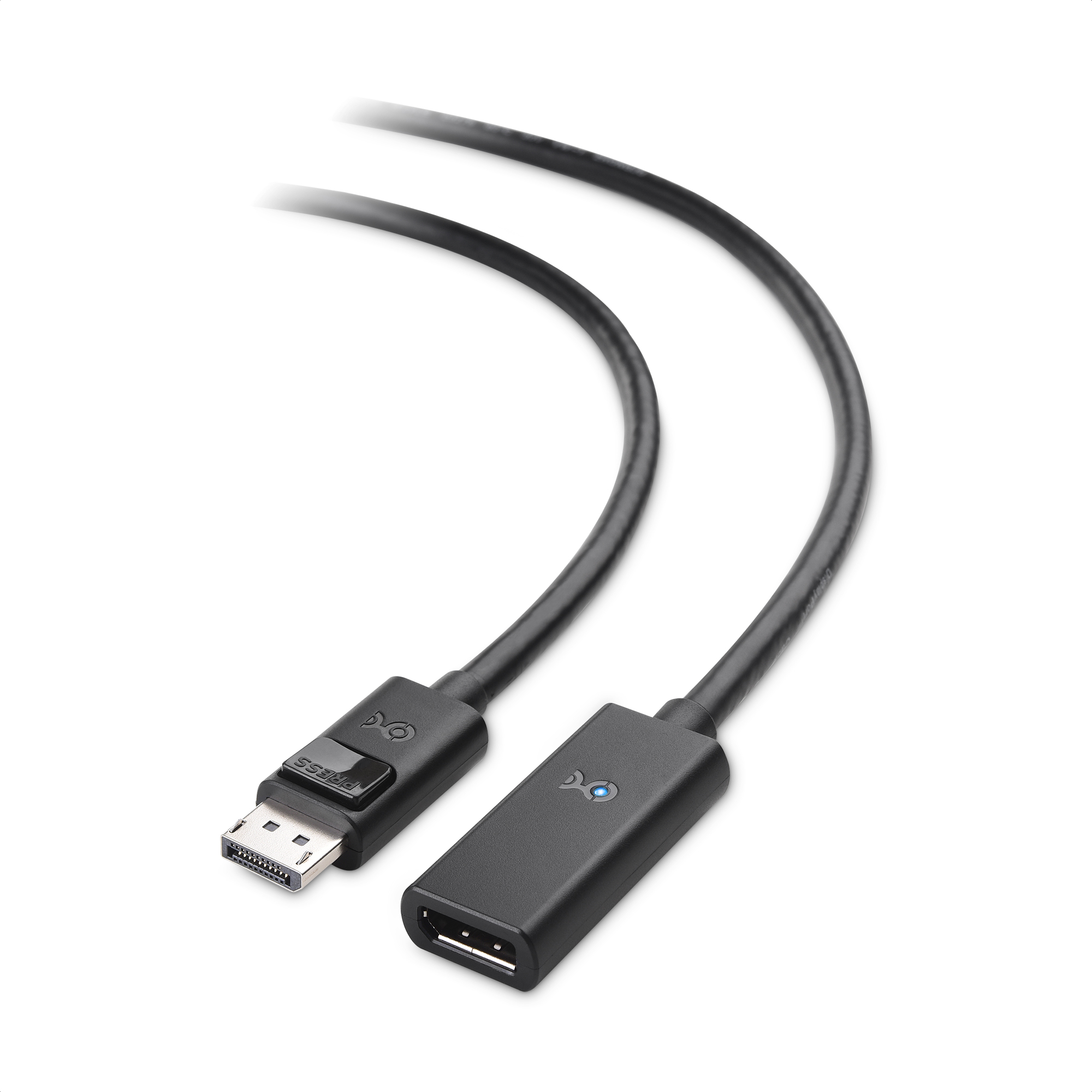what to know about displayport before buying one

If you've owned a loftier-cease monitor or graphics card in the past one-half a decade, chances are you lot've come across that asymmetric connector with the L-shaped header. DisplayPort. Information technology'due south not as commonplace or every bit universal equally HDMI, but it is 1 of the about of import because as far as connectors and cables go, information technology's far more capable.
But DisplayPort is more than just a cablevision. It's a set of standards. If you lot want to get the well-nigh out of your PC, your graphics card, or your monitor, and so learning what DisplayPort is used for is an of import stride to take.
At its core, DisplayPort is a digital interface designed to deliver video and audio over a singular cablevision. Much similar HDMI, it can connect a monitor to a data source, like a graphics card, and deliver the video and audio that it's outputting to the display screen.
The DisplayPort connector and cablevision, as sold by Cablevision Matters, is near commonly plant in its full-size form, where information technology has xx pins fitted into an L shape connector. That helps it stand up out from more uniform ports like HDMI, USB-A, and USB-C. Too commonplace is its smaller variant, known every bit Mini DisplayPort, which originally debuted on Apple devices in 2008, before becoming a more commonplace addition to standalone monitors, specially those with a focus on loftier-cease gaming.
Simply nosotros would be remiss in describing what is DisplayPort, without also addressing its use as a form factor in other technologies. That'due south what makes it possible for other protocols, like Intel's Thunderbolt technology, to utilize DisplayPort form factor to deliver data and video beyond a different cable. In the case of Thunderbolt 3, DisplayPort version 1.2 is supported (more on that below).
Whereas connectors similar HDMI are commonly institute on mainstream games consoles, televisions, monitors, and graphics cards, DisplayPort is more than mutual in high-end devices. It'south often seen in gaming monitors or expensive graphics cards, like Nvidia'due south RTX 2000 GPUs, or AMD's RX 5700 Navi cards.
How does DisplayPort work?
At a basic level, DisplayPort works merely similar any other audio and video data connection. You plug one end of the cable into your device, be it a laptop, desktop reckoner, or external graphics card, and the other into your display. The devices may find 1 another and configure things automatically, but y'all may need to use a remote or the controls on your monitor to manually select the DisplayPort input. It'south also possible you'll demand to manually set the right resolution and refresh rate for your display(due south).
In one case yous've done that though, DisplayPort should work just fine.
If you want to know how does DisplayPort work on a more technical level, it utilizes packetized data transmission in a similar manner to Ethernet cables and PCI-Express ports on a motherboard. It is able to transmit what's known as micro packets of data, which embed a clock signal within them, thereby making for a more efficient data transfer stream that tin can, in plough, back up higher resolutions and refresh rates.
This is a great reward over more traditional display standards and technologies like VGA, DVI, and even HDMI. Information technology, and the more than open, expandable nature of DisplayPort, which allows it to be added to and iterated upon over time, brand it arguably 1 of the nigh of import brandish technologies of the by decade.
What is DisplayPort used for?
The near common use of DisplayPort is in consumer technology. You'll detect DisplayPort connectors on high-end PC graphics cards, on sure laptops, and on a number of capable monitors that support higher resolutions and refresh rates. The standard is as well incorporated in some USB-C ports and in every Thunderbolt connector, in particular, the latest-generation of Thunderbolt 3, which are plant in abundance on Apple products. An easy way to understand how this is works is that although USB-C & Thunderbolt three use a dissimilar connector than DisplayPort, DisplayPort'southward underlying technology, or protocol, is used to send the video data through those ports. This is great news for owners of newer laptops containing but a few USB-C ports, as they tin still be continued to DisplayPort and other displays using a number of USB-C display adapters or Thunderbolt 3 adapters.
Although it is becoming more commonplace as the technology evolves, DisplayPort is more typically plant in higher-end devices that require the kind of bandwidth and feature back up it offers over more mainstream technologies like HDMI. That typically means loftier-end gaming devices and hardware. Gamers don't necessarily have to use that port, only unless their monitor or Boob tube besides supports the newest HDMI ii.1 standard, DisplayPort is effectively mandatory, as the just applied science that supports both loftier resolutions and high refresh rates simultaneously (more on that beneath).
DisplayPort technology works for both external and internal brandish connections, too which is why it besides acts as the link betwixt many Digital TVs' systems-on-bit controllers and their brandish panels timing controller, using iDP applied science.
Why use DisplayPort?
DisplayPort has a number of advantages from a manufacturing standpoint, from a greater bandwidth to expansive feature sets that tin exist added to over time, to greater integration with new ports and standards like Thunderbolt. From a consumer'due south perspective, still, the greatest advantages are in support for college resolutions and refresh rates, often simultaneously.
Where common HDMI connections like the 2.0 standard can support up to 5K resolution at xxx Hz, and 4K resolution at 60Hz, DisplayPort 1.4 tin can support double the refresh rates at the aforementioned resolution and supports 8K resolution at upward to 30Hz. The latest generation of the technology, DisplayPort 2.0, ups the dues even further, supporting up to 16K resolution and up to twin 8K displays at loftier refresh rates.
An fifty-fifty more elementary answer equally to why use DisplayPort, though, is that your monitor or graphics bill of fare requires it. Chances are both will have an culling like HDMI or DVI, built-in, only if you lot have a virtual reality headset, or secondary display already using that engineering, and then DisplayPort may be all that'due south left to you.
Fortunately, even if y'all don't have the DisplayPort connector on the monitor, there are plenty of converter and adapter options yous can utilise. You'll find DisplayPort adapters to connect to HDMI, DVI, VGA, and Mini DisplayPort monitors. It gets a little complicated considering some are "Active" while others are "Passive." On a technical level, you'll need an active adapter if your data source, such every bit your graphics carte du jour, doesn't back up DisplayPort dual way, or DP++. Most modern graphics cards do but double cheque yours before you lot buy a DisplayPort adapter.
For about users, nevertheless, the only existent difference is size and cost. Active DisplayPort converters tend to exist larger and more than expensive because they include additional, in-adapter signal processing chips, where passive adapters utilize DP++ to practise the heavy lifting for them and are more of a mere concrete interface converter. Active DisplayPort adapters are necessary for an Eyefinity multi-display setup where y'all're converting to more than than 2 monitors.
How many Hz does DisplayPort back up?
When we discuss Hz or Hertz, in relation to DisplayPort, what nosotros're really referring to is the kind of monitor refresh rates that DisplayPort supports. In a broad sense, DisplayPort supports just about every mainstream resolution that you might care most, from 30Hz, right up to 240Hz. Simply when it comes to your particular hardware, how many Hz does DisplayPort support, really depends on how many monitors yous're running, what resolution they're set up to, and what version of DisplayPort connector y'all're running them off of.
DisplayPort ane.4 is the most common found on mainstream gaming monitors and graphics cards. Information technology supports the same refresh rates and resolutions as DisplayPort 1.iii (without compression), and can handle 4K at up to 120Hz, two 4K displays at 60Hz, and upwards to four displays at 2,560 x 1,600 at 60Hz. With Display Stream Compression (DSC) it offers the aforementioned resolution and refresh rate support, but with improved color support. Every DisplayPort version since one.2 has been able to offer 240Hz at 1080p resolution.
The DisplayPort 2.0 standard was only announced by its governing body, VESA, in mid-2019, but when supporting monitors, laptops, and graphics cards start to appear, they volition offering higher refresh rates and resolutions than anything else out at that place. It volition add support for two 4K monitors running at up to 144Hz at the aforementioned time, or a unmarried 16K brandish with HDR enabled (with DSC compression).
DisplayPort is for everyone
DisplayPort technology may typically be found in higher-end devices, acting every bit a more premium connection blazon to HDMI's mainstream solution. Merely even as that competing cable standard evolves, DisplayPort is still leaps and bounds ahead in both resolution and refresh rate support, as well every bit features.
As DisplayPort becomes always more effective and better integrated with other technologies like Thunderbolt and USB-C, information technology could well become the dominant display technology standard for years to come. At the very to the lowest degree, it's a standard that y'all know won't hold back whatever you want to practice on your compatible devices.
Where to buy DisplayPort cables?
If yous're looking for DisplayPort cables, Cable Matters has you covered. Cable Matters carries a big array of high-end DisplayPort i.4 cables – from standard passive cables, to more than advanced agile cables designed for reliability across longer lengths.
Cablevision Matters DisplayPort 1.4 Cable

Cablevision Matters Active DisplayPort 1.iv Cable

Cable Matters Active DisplayPort 1.4 Extension Cable
Source: https://www.cablematters.com/blog/DisplayPort/what-is-displayport
0 Response to "what to know about displayport before buying one"
Post a Comment